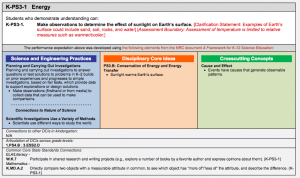GLOBE teachers across the United States are hearing more and more everyday about the Next Generation Science Standards (NGSS). My home state of Michigan was one of twenty-six Lead States that were involved in the process of reviewing the standards and  suggesting changes. Hopefully, Michigan will soon adopt the standards, which will replace our current Science Grade Level Content Expectations (GLCE) and High School Science Content Expectations (HSSCE). Eight states have adopted the standards, as of this writing. The development of the standards has taken nearly two and a half years. But during this time, there still seems to be confusion in mistaking the NGSS with the Common Core.
suggesting changes. Hopefully, Michigan will soon adopt the standards, which will replace our current Science Grade Level Content Expectations (GLCE) and High School Science Content Expectations (HSSCE). Eight states have adopted the standards, as of this writing. The development of the standards has taken nearly two and a half years. But during this time, there still seems to be confusion in mistaking the NGSS with the Common Core.
The NGSS is NOT the Common Core in Science. NGSS is a set of standards that were developed outside of the Common Core process. There are a few reasons causing this confusion:
- They were developed during the adoption process of the Common Core.
- The Common Core in English Language Arts (ELA) contains literacy standards for science, which help students improve their ELA skills in the science content area, but they are not science standards.
- The NGSS contain connections to the Common Core.
A Standard in the Next Generation Science Standards is composed of three parts:
- Performance Expectation(s) which describe what a student is expected to do at the end of instruction. Performance Expectations are composed of three dimensions – a science / engineering practice; a disciplinary core idea in life, physical or earth science; and a crosscutting concept which provides unity across the disciplines of science.
- Foundation Boxes which contain the learning goals that students should achieve through the science / engineering practices; disciplinary core ideas; and crosscutting concepts. The information in the foundation boxes is taken directly from the “A Framework for K-12 Science Education” which provides the foundation for the standards.
- Connection Boxes, which identify science connections across grade levels and disciplines as well as identifying connections to the Common Core State Standards in Mathematics and ELA.
These connection boxes provide a wealth of information for teachers and curriculum developers in aligning and integrating science, mathematics and English Language Arts.  Here is an example of a standard from the NGSS that provides a connection to the Mathematics Common Core:
Here is an example of a standard from the NGSS that provides a connection to the Mathematics Common Core:
- Grade Level – Middle School (6th – 8th Grade)
- Topic – Weather and Climate
- Performance Expectations
- MS-ESS2-5. Collect data to provide evidence for how the motions and complex interactions of air masses results in changes in weather conditions.
- MS-ESS2-6. Develop and use a model to describe how unequal heating and rotation of the Earth cause patterns of atmospheric and oceanic circulation that determine regional climates.
- MS-ESS3-5. Ask questions to clarify evidence of the factors that have caused the rise in global temperatures over the past century.
- Connection Boxes for Mathematics
- MP.2 – Reason abstractly and quantitatively.
- 6.NS.C.5 – Understand that positive and negative numbers are used together to describe quantities having opposite directions or values (e.g., temperature above/below zero, elevation above/below sea level, credits/debits, positive/negative electric charge); use positive and negative numbers to represent quantities in real-world contexts, explaining the meaning of 0 in each situation.
- 6.EE.B.6 – Use variables to represent numbers and write expressions when solving a real-world or mathematical problem; understand that a variable can represent an unknown number, or, depending on the purpose at hand, any number in a specified set.
- 7.EE.B.4 – Use variables to represent quantities in a real-world or mathematical problem, and construct simple equations and inequalities to solve problems by reasoning about the quantities.
These connection boxes are an extremely important component of the NGSS. Without the connection boxes, we do not have standards, we only have performance expectations with foundation descriptions containing learning goals. There are rumors that some states will only adopt the performance expectations without the foundation and connection boxes. This should be avoided at all costs. One of the major goals of the NGSS is to have science standards, which coordinate with “Common Core Standards” in English Language Arts and Mathematics.
So, the next time you hear someone call the new science standards “the common core” remind them that they are not the common core, but they are a new set of science standards called the “Next Generation Science Standards,” which provide a critical connection to the common core in mathematics and ELA.
For more information, check out GLOBE’s NGSS Pinterest page and NGSS Webinars for resources and connections to NGSS.
David Bydlowski
GLOBE Partner — Wayne County Mathematics and Science Center at Wayne RESA

David,
You hit on an extremely important idea related to the NGSS, taking any part without including the other parts simply reduces the strength of the structure. The NGSS were designed to be developed using all of the components of the structure with which it was formed. If you pick and chose the parts you think are “important” you have missed the entire concept behind the NGSS.
I couldn’t said any better Tina. I will be forwarding over this blog to a few of my friends that are in the school district.
My latest blog post regarding Common Core supports your post. http://www.commoncorelessonplantemplate.net/common-core-lesson-plan-template-is-important-to-teach-children-a-good-habit/
Thanks for a great site you have
NGSS is tottaly new to me and concept you gives to me are almost clear
If you pick and chose the parts you think are “important” you have missed the entire concept behind the NGSS.
If you pick and chose the parts you think are “important” you have missed the entire concept behind the NGSS.
Interesting blog on Next Generation Science Standards (NGSS). Our future generation has a lot ahead of them. Thank you again for your blog.